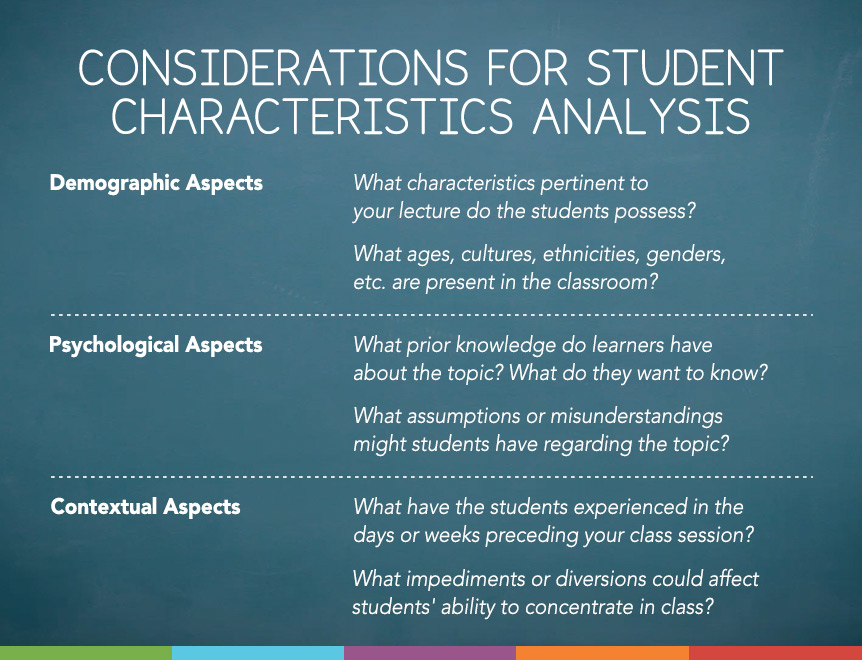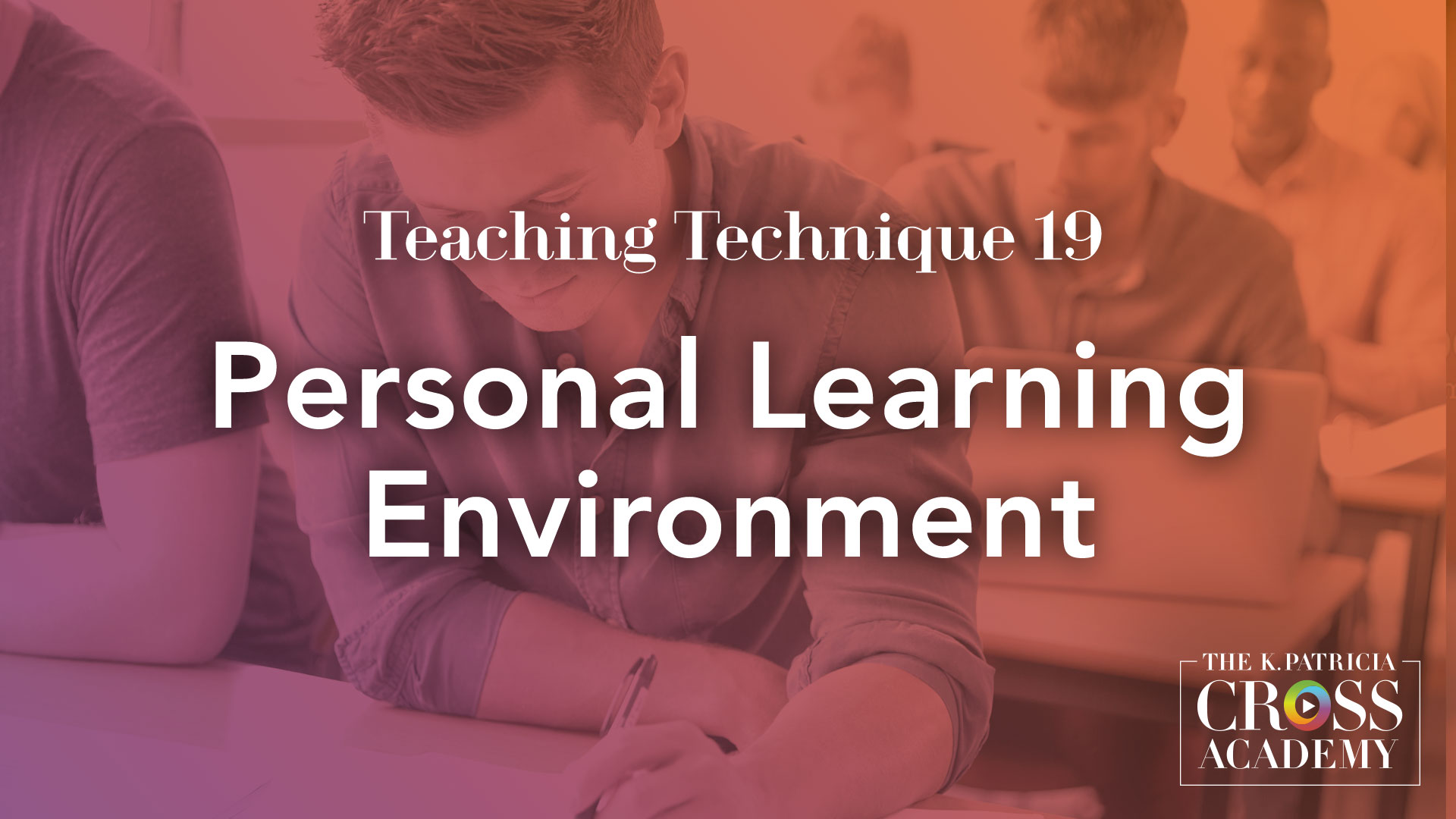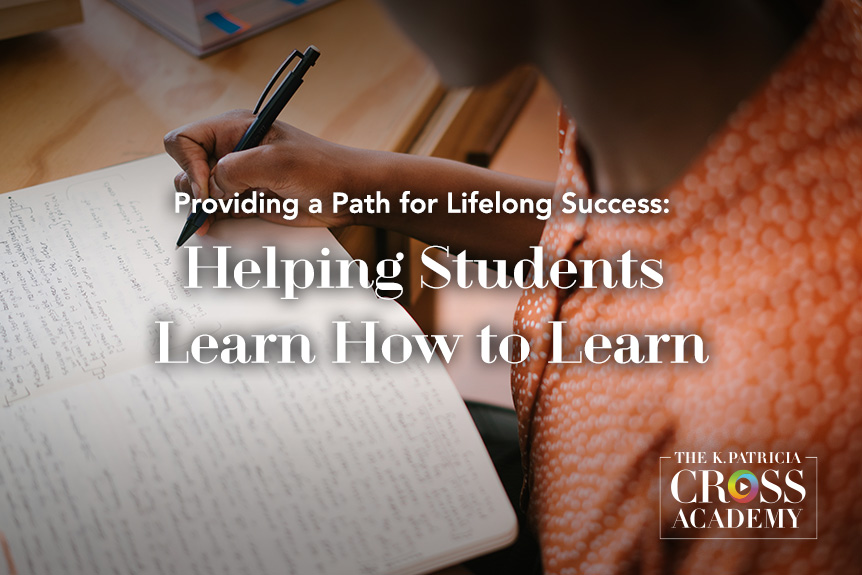
Just as effective public speakers acknowledge the importance of knowing their audience, so do effective college teachers understand the importance of knowing essential characteristics about their students. Students’ intellectual, social, and emotional traits influence the effectiveness and efficiency of their learning. Understanding these characteristics helps ensure a good fit between what you are trying to teach and what students are trying to learn. To construct and present the best possible class sessions, it is helpful to know not only who the students are but also where they stand on a particular topic or issue. As Stephen Brookfield suggests:
We may exhibit an admirable command of content, and possess a dazzling variety of pedagogical skills, but without knowing what’s going on in our students’ heads, that knowledge may be presented and that skill exercised in a vacuum of misunderstanding.
(Brookfield, 2006, p. 74)
A Student Characteristics Analysis is a technique for discovering who students are, what they think, and how to reach them most effectively. A Student Characteristics Analysis conducted before a lecture might assist you in creating a better experience for both you and the students. Gathering information about students prior to the lecture, for instance, will allow you to discover knowledge that helps you to establish common ground with them. A well-executed Student Characteristics Analysis can provide information and insights to help you focus your message, select the most appropriate content and images, and customize your presentation to meet the needs of a specific set of students. In addition, being well-prepared will make you feel more confident when teaching.
Main Idea
By analyzing student traits, you can better understand your audience and tailor your message accordingly. A Student Characteristics Analysis investigates pertinent student traits that may be associated with a subject of study. It paints a clear, convincing, and comprehensive portrait of the learners.
Demographic Aspects
When doing a Student Characteristics Analysis, several elements may be important to how you craft the lecture. Depending on your topic and message, you may need to consider demographic considerations, for instance. Consequently, you might consider the following questions:
- What are the students’ ages?
- Which genders are present in the classroom?
- Are the students of a certain race, culture, or ethnicity?
- Do all learners speak the same primary language? Do you as well?
- What are their spiritual and religious beliefs?
- What is their degree of education?
- What personality types do they possess? For example, they may be introverts or extroverts.
- What further characteristics pertinent to your lecture do they possess? Are they married? Cell-phone users? Avid readers? Runners?

Psychological Aspects
In lieu of (or in addition to) demographic variables, you might additionally evaluate the applicability of certain psychological aspects. Consider if it is essential to know:
- What prior knowledge do learners have about the topic? What do learners want to learn? Want to know?
- Do students require prior knowledge or specific vocabulary to comprehend the meaning of the lecture?
- What concepts, processes, or abilities do students possess?
- Do learners have recent experiences relevant to the topic?
- What assumptions or misunderstandings might students have regarding the topic?
- What are students’ attitudes on the topic? What prior assumptions do they possess?
- Are students impartial, or do they have a predisposition to either agree or disagree with your ideas?
- What are their expectations for the lecture?
Contextual Aspects
Additionally, you may desire to evaluate the most significant contextual aspects. What circumstances surround your teaching? Where and when will you be teaching? Perhaps having answers to the following questions would be useful:
- Is student attendance required or voluntary?
- What have the students experienced in the days or weeks preceding your class session?
- What types of instructional methods will the students anticipate?
- What impediments or diversions could affect students’ ability to concentrate in class?

There are several methods for collecting data for a Student Characteristic Analysis. You may collect existing information, such as students’ major field of study, degree of education, and so forth from the student information system of your institution. Additionally, you may collect information from other instructors. For instance, if your course has prerequisites, you could contact the professor(s) of the prior course(s) for further student information. There are numerous methods for soliciting information from students. For example, you could conduct a quick survey or informal poll online prior to class or at the beginning of class by simply asking students to raise their hands in response to yes or no questions.
A well-executed Student Characteristics Analysis can provide information and insights to help you focus your message, select the most appropriate content and images, and customize your presentation to meet the needs of a specific set of students.
Example
See the following example of a professor who used a Student Characteristics Analysis in her class:
A lecturer was planning a lesson on U.S. immigration and was aware that students would hold strong opinions on the subject. She decided to conduct an anonymous survey to have a better understanding of how students felt about crucial subjects. She was able to find an existing survey (https://www.isidewith.com/polls) that she could modify and then administer online two days before the lecture through a short online search. In addition to using survey responses to predict students’ emotional responses to her lectures and target her main message, she used the survey results as a prompt for a follow-up discussion, closing by comparing class responses to national replies to the same questions. Below is a sample of her survey’s questions.
Part 1: Demographics
1. What is your age?
- 18-20
- 21-22
- 23-25
- 26-35
- 36-45
- Older than 46
2. What is your gender?
- Man
- Woman
- Gender Queer
- Gender Fluid
Part 2. Beliefs Related to Immigration
3. Should immigrants be deported if they commit a serious crime?
- Yes
- No
- Yes, but after they have finished their sentence
- Yes, as long as it is safe to return to their country
- No, only if they have entered the country illegally
4. Should the U.S. build a wall along the southern border?
- Yes, but make it a high-tech surveillance barrier instead of a physical one
- Yes, and Mexico should pay for it No, this would be too costly and ineffective
- No, but increase our military presence along the southern border
- No, and we should adopt an open border policy
5. Should illegal immigrants have access to government-subsidized healthcare?
- Yes
- No
- Yes, if they pay taxes
- Yes, but only for life threatening emergencies or infectious diseases
- Yes, and grant them citizenship
- Yes, but they should be deported after treatment
- No, but they should be allowed to purchase private healthcare
- No, but their children should have access
- No, and we should deport all illegal immigrants
- No, and the government should never subsidize healthcare
Part 3. Contextual Considerations
6. Do you plan to attend the next class session which focuses on immigration?
- Yes
- No
7. If you answered yes to the above, what is the most important reason you will attend class?
- Because attendance is required
- Because I would like to learn more about immigration issues
- Because I have strong feelings about immigration issues
8. If you answered no to the above, what is the most important reason you will not attend class?
- Because I have a conflict
- Because I am not interested in immigration issues
- Other ___________________________________________
What are some Cross Academy Techniques I can use to get to know student characteristics better?
A survey early in the class (such as that in our example above) is an efficient way to gather data on student characteristics, but if you believe more in-depth information would be useful, consider adapting one of the following Cross Academy Techniques.
A PLE is a set of people and digital resources an individual can access for the specific intent of learning. Students illustrate their potential connections through a visible network of the set.
Students use computer-based tools, such as video, audio, graphics, and web publishing, to tell personal or academic stories about life experiences relevant to course themes.
In Dyadic Interviews, student pairs take turns asking each other questions that tap into values, attitudes, beliefs, and prior experiences that are relevant to course content or learning goals.
Enter your email below to receive information about new blog posts.
Key Reference and Resources
Barkley, E. F., & Major, C. H. (2018). Interactive lecturing: A handbook for college faculty. Jossey Bass/Wiley.
Brookfield, S. D. (2006). The skillful teacher: On technique, trust, and responsiveness in the classroom (2nd ed.). Jossey-Bass.
Eberly Center for Teaching and Learning. (2008). Recognize who your students are [Web page]. Carnegie Mellon University.
https://www.cmu.edu/teaching/designteach/design/yourstudents.html
Suggested Citation
Barkley, E. F., & Major, C. H. (n.d.). Getting to know you: How to do a student characteristics analysis. CrossCurrents. https://kpcrossacademy.org/getting-to-know-you-how-to-do-a-student-characteristics-analysis/

Engaged Teaching
A Handbook for College Faculty
Available now, Engaged Teaching: A Handbook for College Faculty provides college faculty with a dynamic model of what it means to be an engaged teacher and offers practical strategies and techniques for putting the model into practice.








